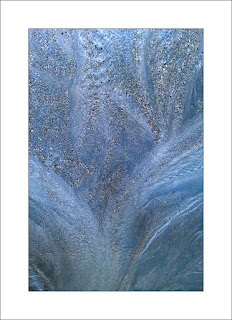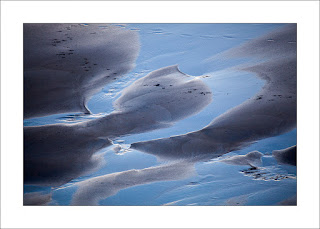I tend to steer clear of photographing fast moving subjects. I am not sure why but it probably goes back to the reason I started landscape photography. Basically, photography was a slow down activity and a pleasant diversion from the stresses of working. Standing with a tripod waiting for the light to change was far more relaxing than rapid burst photography.
Occasionally, however, an opportunity like the Red Arrows in Falmouth presents itself and I try to get some shots that aren't blurred. Of course, the precision flying skill and the display routines of the Red Arrows makes it much easier to get a few sharp ones!
Sunday 22 October 2017
Red Arrows
Labels:
Aeroplanes,
Colour,
Cornwall,
Falmouth,
Jets,
Red Arrows
Location:
Falmouth, UK
Thursday 19 October 2017
Sand Blues
Building on the technique outlined in my previous post is a set of inverted sand pattern images.
The dominate colour in sand is yellow so when it is inverted it changes to tones of blue. The original light areas show as a darker blue and the dark areas as a lighter tone. As a result, the mind stops constructing 'sand' and now starts interpreting texture, pattern and tone in an abstract form - which makes it more interesting as a composition.
The same technique used on seaweed:
The dominate colour in sand is yellow so when it is inverted it changes to tones of blue. The original light areas show as a darker blue and the dark areas as a lighter tone. As a result, the mind stops constructing 'sand' and now starts interpreting texture, pattern and tone in an abstract form - which makes it more interesting as a composition.
The same technique used on seaweed:
Monday 16 October 2017
Shadowy Ferns
Following my break from photoblogging I have now decided to drop the week-by-week order that I have previously used for my posts. This reflects the reduced number of outings with the camera during the summer and it allows me more flexibility with the content.
Working week-by-week has been beneficial though. The discpline of taking photos virtually every day has gradually altered my approach to photography. These days I am more likely to construct an image based on the components of a composition rather than a picture or a scene. Components include lines, angles, shapes, patterns, textures, light, shade, colours, and tones. Images constructed in this way tend to be more interesting and ocassionally more challenging to look at and interpret. That said, I still like pictorial representations but these tend to be a small part of my photographic output. The following selection is an example of this changed approach.
Ferns in summer tend to be a mass of green which often does not translate well for photography. Within that mass are some wonderful shapes and curves but the problem is how to isolate these in the image. The solution involves inverting the image so the dark areas become light and the light areas become dark. It works best if light is catching the subject frond(s) and there is shadow behind. When inverted the subject becomes dark and background ferns become faint and shadow-like. A conversion to black and white is required for the final finish:

Working week-by-week has been beneficial though. The discpline of taking photos virtually every day has gradually altered my approach to photography. These days I am more likely to construct an image based on the components of a composition rather than a picture or a scene. Components include lines, angles, shapes, patterns, textures, light, shade, colours, and tones. Images constructed in this way tend to be more interesting and ocassionally more challenging to look at and interpret. That said, I still like pictorial representations but these tend to be a small part of my photographic output. The following selection is an example of this changed approach.
Ferns in summer tend to be a mass of green which often does not translate well for photography. Within that mass are some wonderful shapes and curves but the problem is how to isolate these in the image. The solution involves inverting the image so the dark areas become light and the light areas become dark. It works best if light is catching the subject frond(s) and there is shadow behind. When inverted the subject becomes dark and background ferns become faint and shadow-like. A conversion to black and white is required for the final finish:

Wednesday 11 October 2017
Godrevy Towans
Initially I was only going to take a couple of months away from photoblogging but time has moved on so quickly I find myself preparing for the Autumn colours....my favourite season of the year.
During the summer I continued with photography but reduced the number of outings with the camera. Instead, I spent more time looking at art, drawing, and reading the type of books that I disliked or couldn't relate to at school. Graphite drawing has taken most of my time, developing techniques whilst using my photographs as subjects. I touched on this in my last post and in the coming weeks I will share some of my latest efforts..
Taking a break was all about improving my photography. I wasn't convinced that I could do this by simply taking more photographs. I wanted to divert my mind to something else in order to gain a new perspective or a new creative drive.
I can't say whether this has worked as yet or whether anything will change. Transitioning from competent landscape photographer to the next level is far more difficult than gaining the initial skills.
Perhaps the merest indicator of something different happening was a trip to Godrevy. It wasn't a photographic visit but more of a day out at lovely location. Into the evening I grabbed the camera with the intention of capturing the essence of the day - without taking a shot of the lighthouse which I have captured many times in the last year or so!
The results were a series of images including reflected light in the standing sea water at low tide. They were taken from the top of a cliff with a long lens.
During the summer I continued with photography but reduced the number of outings with the camera. Instead, I spent more time looking at art, drawing, and reading the type of books that I disliked or couldn't relate to at school. Graphite drawing has taken most of my time, developing techniques whilst using my photographs as subjects. I touched on this in my last post and in the coming weeks I will share some of my latest efforts..
Taking a break was all about improving my photography. I wasn't convinced that I could do this by simply taking more photographs. I wanted to divert my mind to something else in order to gain a new perspective or a new creative drive.
I can't say whether this has worked as yet or whether anything will change. Transitioning from competent landscape photographer to the next level is far more difficult than gaining the initial skills.
Perhaps the merest indicator of something different happening was a trip to Godrevy. It wasn't a photographic visit but more of a day out at lovely location. Into the evening I grabbed the camera with the intention of capturing the essence of the day - without taking a shot of the lighthouse which I have captured many times in the last year or so!
The results were a series of images including reflected light in the standing sea water at low tide. They were taken from the top of a cliff with a long lens.
Subscribe to:
Posts (Atom)




































